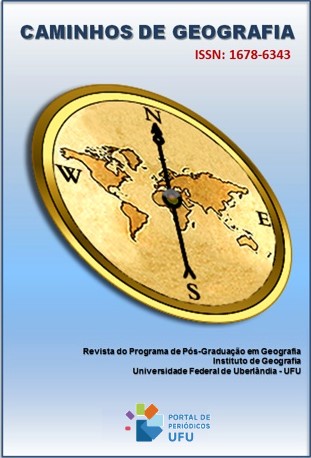MAPEAMENTO DA COBERTURA VEGETAL PARA ATUALIZAÇÃO CARTOGRÁFICA EM MARINGÁ/PR COM USO DE ABORDAGEM ESTATÍSTICA DO NDVI E ÁRVORE DE DECISÃO
DOI:
https://doi.org/10.14393/RCG249365520Palavras-chave:
GEE, Classificação, Escala, Uso do solo, Sentinel 2AResumo
Este artigo tem como objetivo avaliar o uso de imagens orbitais do sensor MSI, satélite Sentinel 2A, para o mapeamento da vegetação na área correspondente à carta topográfica de Maringá (PR), folha SF-22-Y-D-II-3. O índice NDVI foi a variável espectral selecionada, e com uso do Google Earth Engine foram processadas nove imagens entre fev/2021 e jan/2022. As classificações se pautaram nas imagens-estatísticas de média e desvio-padrão, ao invés das imagens individuais. Foram testados dois métodos de classificação, um por fatiamento simples, e o outro método foi a árvore de decisão (algoritmo J48), em que foram usados 413 pontos de referência. Os resultados mostraram que o classificador por árvore de decisão apresentou resultados ligeiramente melhores do que o fatiamento simples, com índices Kappa iguais a 0,893 e 0,877, respectivamente. A árvore de decisão utilizou a média como principal variável, mas quando ela esteve entre 0,6678 e 0,7504 os pixels foram classificados também com o uso do desvio-padrão. O fatiamento simples classificou mais áreas como vegetação, enquanto a árvore de decisão classificou menos áreas. Enquanto o primeiro classificador seria mais indicado para o mapeamento de áreas de preservação, independentemente do porte da vegetação, o segundo seria mais indicado para o mapeamento de coberturas florestais.
Downloads
Downloads
Publicado
Edição
Seção
Licença
Copyright (c) 2023 Américo José Marques, Otávio Cristiano Montanher

Este trabalho está licenciado sob uma licença Creative Commons Attribution-NonCommercial-NoDerivatives 4.0 International License.
Autores que publicam nesta revista concordam com os seguintes termos: a) Autores mantém os direitos autorais e concedem à revista o direito de primeira publicação, com o trabalho licenciado sob a Creative Commons Atribuição-NãoComercial-SemDerivações 4.0 Internacional. b) Autores têm permissão e são estimulados a publicar e distribuir seu trabalho online (ex.: em repositórios institucionais ou na sua página pessoal), já que isso pode gerar alterações produtivas, bem como aumentar o impacto e a citação do trabalho publicado. c) Em virtude de aparecerem nesta revista de acesso público, os artigos são de uso gratuito, com atribuições próprias, em aplicações educacionais e não-comerciais.











